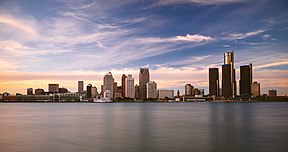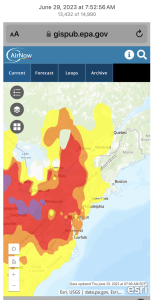Chapter 12: Urban and Suburban Spaces
12.3 Processes that Define Cities
12.3.1 Economic changes
Local histories and physical landscapes contribute to the uniqueness and differences in cities. In addition, ongoing changes in the economy, demography, technology and environment contribute to the global sense of place.
These changes are often dynamic and exist on many scales. An economic change may be, for example, the shift from a subsistence-based economy to one of pre-capitalist trade or, in contemporary society, a shift in the form of capitalist accumulation.[1] In cities, capitalist accumulation manifests through real estate development, commercial expansion, and infrastructure projects. Investors and businesses seek to maximize profits by developing property, attracting high-value tenants, and improving infrastructure, which can drive economic growth and urban transformation. Cities, as sites of resource agglomeration, are key actors within the network of global economic activity. Cities gather, regulate, produce and redistribute capital in the form of physical resources, money and human labor. As well, cities have their own regional and local economies in their hinterland that are connected to broader economic flows.
Within cities, as well as among cities, capital is unevenly distributed between people, which causes shifting demographic, political and sociocultural changes.
Detroit, MI

Source: "Detroit Skyline (123143197)" by Rodrigo.Argenton via Wikimedia Commons is licensed under CC0 1.0.
The city of Detroit, Michigan, in the United States, has witnessed significant economic changes over the past decades, primarily due to the decline of the automotive industry. However, Detroit has responded by revitalizing its downtown area, diversifying its economy, and fostering entrepreneurship and innovation. Investments in urban redevelopment, along with a focus on emerging industries such as healthcare, education, advanced manufacturing, and technology, have begun reshaping Detroit's economic landscape. While these changes have brought new opportunities for growth and community development, they also pose challenges such as gentrification and economic disparities. Overall, Detroit's economic transformation reflects a shift from reliance on traditional industries to a more diverse and innovative economy, driven by adaptation and collaboration between public and private sectors.
12.3.2 Demographic changes
Such changes refer to the size, composition and speed of change in the population that profoundly affect urban landscapes. For example, the graph below is showing the fastest growing cities in the United States between July 2021 and July 2022.
| The 15 Fastest-Growing Large Cities Between July 1, 2021, and July 1, 2022, With Populations of 50,000 of More on July 1, 2021 | ||||
|---|---|---|---|---|
| Rank | Area Name | State | Percent Increase | 2022 Total Population |
| 1 | Georgetown city | Texas | 14.4 | 86,507 |
| 2 | Santa Cruz city | California | 12.5 | 61,800 |
| 3 | Kyle city | Texas | 10.9 | 57,470 |
| 4 | Leander city | Texas | 10.9 | 74,375 |
| 5 | Little Elm city | Texas | 8.0 | 55,357 |
| 6 | Westfield city | Indiana | 7.7 | 54,605 |
| 7 | Queen Creek town | Arizona | 6.7 | 70,734 |
| 8 | North Port city | Florida | 6.6 | 85,099 |
| 9 | Cape Coral city | Florida | 6.4 | 216,992 |
| 10 | Port St. Lucie city | Florida | 6.4 | 231,790 |
| 11 | Conroe city | Texas | 6.3 | 101,405 |
| 12 | Maricopa city | Arizona | 6.2 | 66,290 |
| 13 | New Braunfels city | Texas | 5.7 | 104,707 |
| 14 | Lehi city | Utah | 5.6 | 84,373 |
| 15 | Medford city | Massachusetts | 5.2 | 65,399 |
| Source: U.S. Census Bureau, Population Division, Vintage 2022 Population Estimates, release date: May 2023. | ||||
Figure 12.3.2 The 15 Fastest-Growing Cities in the US – July 2021 – July 2022
Retrieved from Retrieved from United States Census Bureau Press Release Number CB23-79
12.3.3 Political change
Political change occurs at various scales (international, federal, provincial and municipal) also has important effects on cities (see our chapter on political geography). Governments have the power to levy taxes and to redistribute resources. They make laws that regulate everything from environmental and economic activity to managing migration. Shifts in political agendas can mean the difference between securing funding for a local health authority versus public transit in the region.
COVID-19 Handling Lockdowns
A good example of how political change affected U.S. cities is the response to the COVID-19 pandemic by various mayors across the country. In cities like New York City, Los Angeles, and Chicago, mayors implemented stringent lockdown measures, including business closures, restrictions on public gatherings, and mask mandates, in an effort to curb the spread of the virus and protect public health. These decisions had significant economic ramifications.
In contrast there were cities where lockdown measures were not implemented or were lifted relatively early compared to others. One notable example is the city of Atlanta, Georgia. During the COVID-19 pandemic, the Atlanta mayor did not implement strict lockdown measures. While there were restrictions in place, such as limits on gathering sizes and mask mandates, Atlanta did not enforce business closures or stay-at-home orders to the same extent as cities like New York or Los Angeles. Instead, the city focused on targeted measures such as increased testing and contact tracing, along with promoting social distancing and mask-wearing. The death toll per capita was below that of New York City and L.A.
This approach led to debates and criticisms regarding the balance between protecting public health and supporting economic activity. Some argued that Atlanta's more lenient approach prioritized economic recovery and individual freedoms, while others expressed concerns about the potential for increased spread of the virus and strain on healthcare systems.
Ultimately, the differing responses to lockdown measures across cities in the United States reflected varying interpretations of public health guidelines, local economic considerations, and political dynamics.
12.3.4 Sociocultural changes
Sociocultural changes a ffect everything from architectural style to the kinds of amenities that are provided in cities. For example, some cities may be known for their natural beauty, so cities often highlight local access to outdoor activities such as hiking, skiing or cycling. Sociocultural change is broader than physical attributes, however. Behavior toward minority groups has also altered drastically within cities over the years. For example, from 1859 to 1923, Canada levied the Chinese head tax, a fee charged to each Chinese person entering Canada. It was abolished in 1923 by the Chinese Immigration Act, which prohibited immigration from China to Canada. Many years later, in 2006, the federal government offered an official apology and financial remuneration to survivors and their spouses who paid the head tax.
Sociocultural Change in Chinatown Neighborhoods

Source: "Friendship Archway Washington, D.C." by APK via Wikimedia Commons is licensed under CC BY 4.0.
An example of a sociocultural change within a minority group in a city is the evolution of Chinatown neighborhoods in cities like San Francisco, New York City, and Chicago. Historically, Chinatowns served as ethnic enclaves for Chinese immigrants, providing a sense of community, cultural preservation, and economic opportunities. However, in recent years, Chinatown neighborhoods have undergone significant transformations due to various sociocultural factors.One notable change is the shifting demographics within Chinatown communities, with younger generations of Chinese Americans moving away from these neighborhoods in pursuit of better educational and economic opportunities elsewhere. This demographic shift has led to concerns about the preservation of cultural heritage and traditions within Chinatown, as well as debates about gentrification and urban development.
Additionally, Chinatown neighborhoods have increasingly become destinations for tourists seeking authentic cultural experiences, leading to the commercialization of certain aspects of Chinatown culture and cuisine. While tourism can bring economic benefits to Chinatown businesses, it also raises questions about authenticity, cultural commodification, and the impact on local residents and businesses.

Source: A screenshot of the National Trust for Historic Preservation's Preserving Chinatowns in the United States website.
For a complete view of the storymap - a slide of which you see above - showing the fascinating story of preserving Chinatowns, visit Preserving Chinatowns in the United States by Karen Yee.
Another significant sociocultural change within a city, influenced by historical redlining practices, is the persistent racial and economic segregation evident in many urban areas across the United States. Redlining, a discriminatory lending practice that systematically denied financial services such as mortgage loans to minority communities, particularly African American neighborhoods, has had lasting effects on the social and economic fabric of cities.
The legacy of redlining is evident in the spatial segregation of neighborhoods, with minority communities often relegated to under-resourced areas characterized by inadequate housing, limited access to quality education and healthcare, and higher rates of poverty and crime. These segregated neighborhoods face systemic barriers to socioeconomic mobility, perpetuating cycles of poverty and inequality across generations.

Source: "Home Owners' Loan Corporation Philadelphia redlining map" is in the public domain in the United States.
Efforts to address the sociocultural impact of redlining include initiatives to promote fair housing practices, equitable urban planning, and community-led revitalization projects that aim to improve living conditions, foster social cohesion, and empower residents in historically marginalized neighborhoods. However, the enduring effects of redlining underscore the need for comprehensive approaches to address systemic racism, promote inclusivity, and create opportunities for all residents to thrive in cities.
12.3.5 Technological changes
Technology affects the physical environment and how people live in cities. Economic innovation is often precipitated by technological change. For example, the development of the steam engine was strong enough to power a long-distance railway across much of North America. Today, advances in telecommunications and wireless networks allow people in cities to carry devices that allow mobile Internet access. Cities have also become tech hubs, providing jobs to local economies. Cities such as Tokyo, Japan, or Seoul, South Korea, provide free internet service to all their residents. Additionally, such technological changes make it possible for people to move away from their point of employment and work remotely.
Technological Changes
-

Figure 12.3.6 Smart Technology used in the Greater Washington D.C. Area. (Click the image to enlarge it.)
Source: Screenshot by Barbara Crain.Smart Transportation Systems: Implementation of smart transportation systems, such as intelligent traffic management, real-time public transit tracking, and ridesharing services, can significantly improve mobility within a city. For example, cities like Singapore have adopted advanced traffic management systems that use sensors and data analytics to optimize traffic flow and reduce congestion, enhancing the efficiency of transportation networks and improving air quality.
- Smart Infrastructure: Integration of technology into urban infrastructure can enhance efficiency, sustainability, and resilience. Examples include smart grids for electricity distribution, sensor-equipped waste management systems for optimized collection routes, and green building technologies for energy-efficient construction. For instance, Copenhagen in Denmark has invested in smart street lighting systems that adjust brightness based on pedestrian and vehicular traffic, reducing energy consumption and light pollution.
- Urban Resilience and Disaster Management: Technology plays a crucial role in enhancing urban resilience and disaster preparedness. Cities like Tokyo, Japan, have implemented earthquake early warning systems that use sensors to detect seismic activity and provide alerts to residents, allowing for timely evacuation and reducing casualties. Furthermore, data-driven modeling and simulation tools help urban planners assess risks, develop contingency plans, and mitigate the impact of natural disasters and climate change.
12.3.6 Environmental changes
Cities tie into broad networks. For example, air pollution and water quality cannot be governed or contained at the local level; they require cross-jurisdictional management. Increasing CO2 emissions not only raise local health risks in cities, causing higher rates of asthma and other respiratory illness, but also contribute to global climate change.
Air Pollution in 2023

Source: Screenshot by Barbara Crain.
In 2023, both New York City and Washington, D.C., experienced a significant environmental change in air quality due to wildfires in Canada. Smoke and particulate matter from these fires were carried southward by prevailing winds, affecting air quality in urban areas along the East Coast of the United States.
In response to deteriorating air quality, public health advisories were issued in both cities, warning residents, especially those with respiratory conditions, to limit outdoor activities and stay indoors whenever possible. Additionally, authorities in New York City and Washington, D.C., implemented emergency measures such as the distribution of face masks, the deployment of air quality monitoring stations, and the establishment of cooling centers to provide relief from the smoky conditions.
The impact of Canadian wildfires on air quality in these major metropolitan areas underscored the interconnectedness of environmental factors across geographic boundaries and the vulnerability of urban populations to external sources of pollution. It also highlighted the importance of regional cooperation and proactive measures to address the health risks associated with air pollution events exacerbated by climate change.
Cities worldwide are experiencing the impacts of global warming, including increased frequency and intensity of heatwaves, urban flooding exacerbated by changes in precipitation patterns and rising sea levels, heightened air pollution due to factors such as ground-level ozone formation and intensified smog events, water scarcity challenges driven by changes in precipitation and evaporation rates, and the heightened risks of extreme weather events such as hurricanes, typhoons, and wildfires. From record-breaking temperatures in cities like Phoenix and Sydney to severe flooding in Miami and Jakarta, these impacts underscore the urgent need for climate action to mitigate the effects of global warming, build resilience in urban areas, and protect the health and well-being of urban populations around the world.
Understanding the interrelationship of these various urbanization processes helps us to understand the dynamic role of cities.
- Capitalist accumulation is the process by which capital (money, assets) grows through reinvestment of profits, investments, and other means within a capitalist system. This accumulation often involves expanding business operations, investing in profitable ventures, and in some cases, exploiting labor to generate surplus value. It drives economic growth but can also contribute to social and economic inequalities. ↵

